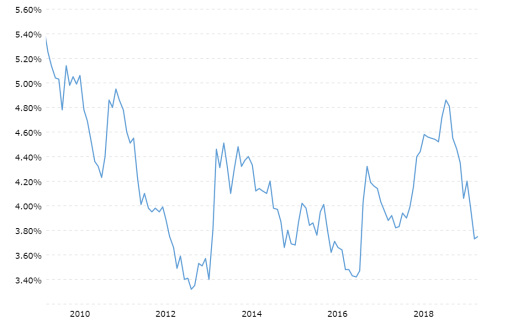By Charles Brown, M. Brown Financial Advisors
Interest rates here in the United States have dropped significantly in the last year. Yields on ten year US Treasury bonds have fallen from over 3% last November to less than 1.6% today (8/14/19)*. Although mortgage rates are very different from US Treasury yields, they are highly correlated.

When we take a look at mortgage rates over the last few years, we can see that this correlation has played out. 30 year fixed mortgage rates (as of July 2019) are now around 3.75%, down from about 4.80% last November**.

With rates as low as they are, is now a good time to refinance your mortgage? Well, it depends.
The first thing you want to do is call a Mortgage Broker / Specialist and get an accurate rate quote for your unique financial situation. A few things that can affect your rate are: home value, home location, loan amount, income and credit score (among others). You also want to get an estimate on closing costs for the loan. Closing costs can also vary based on the factors listed above.
Once you have your quotes, then you can make an educated decision on refinancing your loan. The general rule is that it should take you two years of savings (old monthly payment minus new monthly payment) or less to pay back your closing costs from the refinancing. If it takes longer than two years then it is not worth refinancing.
Quick example: $500,000 mortgage @ 4% interest rate vs potential refinance at 3.75% with $2500 closing costs.
Current monthly payment = $2387
New monthly payment = $2316
Savings = $71 a month
$2500 (closing costs) divided by $71 = 35.2 months to cover closing costs = do not refi
As we saw earlier, mortgage quotes are tied to US Treasury bond prices which change on a daily basis. Be aware that the quote you get today may not be the quote you get next week. The only way to secure the quoted rate is to “lock” the loan by paying a down payment on the closing costs which commits both parties to the loan.
One last thing to consider when we see interest rates this low is to look at a 15 year or 20 year fixed rate mortgage. Many people buy their home when they are just starting out in life and pick a 30 year fixed mortgage because this option keeps the monthly payments as low as possible. If you earn significantly more than when you bought your home and have a secure job (and cash flow), you may want to consider a shorter loan time frame. Mortgage rates on 15 year and 20 year fixed loans are even lower than 30 year fixed mortgages so you can really cut down on your interest expenses two ways: by lowering your interest rate and by paying back the loan quicker (shorter loan term).
Ultimately, each refinance decision is unique so it makes sense to consult a mortgage specialist and a financial planner to assist with the decision.
* Chart from cnbc.com
** Chart from Macrotrends.com – https://www.macrotrends.net/2604/30-year-fixed-mortgage-rate-chart
***The above article is informational in nature only and is not a recommendation to buy or sell securities. All information is gathered from sources believed to be reliable, but neither Charles Brown nor Ausdal Financial Partners, Inc guarantees the accuracy of the information. All investments carry a degree of risk. Individuals should consult with their tax and investment professionals before making changes to their investment portfolios.
****Securities and Investment Advisory services offered through Ausdal Financial Partners, Inc, 5187 Utica Ridge Road, Davenport, IA 52807 (563)326-2064. Member: FINRA/SIPC. M.Brown and Associates / M. Brown Financial Advisors and Ausdal Financial Partners are independently owned and operated.
